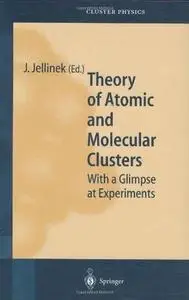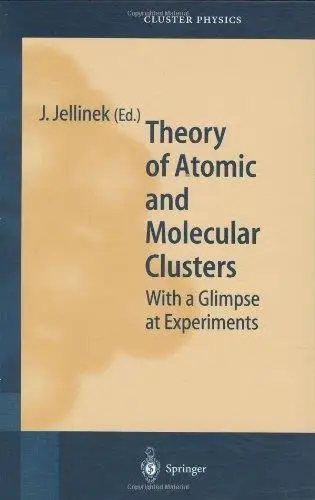The world according to quantum mechanics : why the laws of physics make perfect sense after all By Ulrich Mohrhoff
2011 | 317 Pages | ISBN: 9814293377 | PDF | 3 MB
2011 | 317 Pages | ISBN: 9814293377 | PDF | 3 MB
The book summarises contemporary knowledge about the theory of atomic and molecular clusters. New results are discussed on a high theoretical level. Access to this field of research is given by an explanation of the various subjects in introductory chapters An invaluable supplement to standard textbooks on quantum mechanics, this introduction to the general theoretical framework of contemporary physics focuses on conceptual, epistemological, and ontological issues. Probability : basic concepts and theorems -- The principle of indifference -- Subjective probabilities versus objective probabilities -- Relative frequencies -- Adding and multiplying probabilities -- Conditional probabilities and correlations -- Expectation value and standard deviation -- A (very) brief history of the "old" theory -- Planck -- Rutherford -- Bohr -- de Broglie -- Mathematical interlude -- Vectors -- Definite integrals -- Derivatives -- Taylor series -- Exponential function -- Sine and cosine -- Integrals -- Complex numbers -- A (very) brief history of the "new" theory -- Schrodinger -- Born -- Heisenberg and "uncertainty" -- Why energy is quantized -- The Feynman route to Schrodinger (stage 1) -- The rules of the game -- Two slits -- Interference -- The propagator as a path integral -- The time-dependent propagator -- A free particle -- A free and stable particle -- Special relativity in a nutshell -- The principle of relativity -- Lorentz transformations : general form -- Composition of velocities -- The case against positive K -- An invariant speed -- Proper time -- The meaning of mass -- The case against K = 0 -- Lorentz transformations : some implications -- 4-vectors -- The Feynman route to Schrodinger (stage 2) -- Action -- How to influence a stable particle? -- Enter the wave function -- The Schrodinger equation -- Why quantum mechanics? -- The classical probability calculus -- Why nontrivial probabilities? -- Upgrading from classical to quantum -- Vector spaces -- Compatible an incompatible elementary tests -- Noncontextuality -- The core postulates -- The trace rule -- Self-adjoint operators and the spectral theorem -- Pure states and mixed states -- How probabilities depend on measurement outcomes -- How probabilities depend on the times of measurements -- The rules of the game derived at last -- The classical forces : effects -- The principle of "least" action -- Geodesic equations for flat spacetime -- Energy and momentum -- Vector analysis : some basic concepts -- Curl and Stokes's theorem -- Divergence and Gauss's theorem -- The Lorentz force -- Curved spacetime -- Gravity -- The classical forces : causes -- Gauge invariance -- Fuzzy potentials -- Maxwell's equations -- A fuzzy metric -- Einstein's equation -- Aharonov-Bohm effect -- Fact and fiction in the world of classical physics -- Quantum mechanics resumed -- The experiment of Elitzur and Vaidman -- Observables -- The continuous case -- Commutators -- The Heisenberg equation -- Operators for energy and momentum -- Angular momentum -- The hydrogen atom in brief -- Spin -- Spin 1/2 -- A Stern-Gerlach relay -- Why spin? -- Beyond hydrogen -- Spin precession -- The quantum Zeno effect -- Composite systems -- Bell's theorem : the simplest version -- "Entangled" spins -- Reduced density operator -- Contextuality -- The experiment of Greenberger, Horne, and Zeilinger -- Uses and abuses of counterfactual reasoning -- The experiment of Englert, Scully, and Walther -- Time-symmetric probability assignments -- Quantum statistics -- Scattering billiard balls -- Scattering particles -- Symmetrization -- Bosons are gregarious -- Fermions are solitary -- Quatum coins and quantum dice -- Measuring Sirius -- Relativistic particles -- The Klein-Gordon equation -- Antiparticles -- The Dirac equation -- The Euler-Lagrange equation -- Noether's theorem -- Scattering amplitudes -- QED -- A few words about renormalization -- Beyond QED -- QCD -- Electroweak interactions -- Higgs mechanism -- Pitfalls -- Standard axioms : a critique -- The principle of evolution -- The eigenstate-eigenvalue link -- Interpretational strategy -- Spatial aspects of the quantum world -- The two-slit experiment revisited -- The importance of unperformed measurements -- Spatial distinctions : relative and contingent -- The importance of detectors -- Spatiotemporal distinctions : not all the way down -- The shape of things -- Space -- The macroworld -- Questions of substance -- Particles -- Scattering experiment revisited -- How many constituents? -- An ancient conundrum -- A fundamental particle by itself -- Manifestation -- "Creation" in a nutshell -- The coming into being of form -- Bottom-up or top-down? -- Whence the quantum-mechanical correlation laws? -- How are "spooky actions at a distance" possible? -- Why the laws of physics are just so -- The stability of matter -- Why quantum mechanics (summary) -- Why special relativity (summary) -- Why quantum mechanics (summary continued) -- The classical or long-range forces -- The nuclear or short-range forces -- Fine tuning -- Quanta and Vedanta -- The central affirmation -- The poises of creative consciousness



